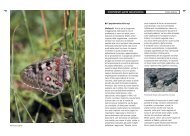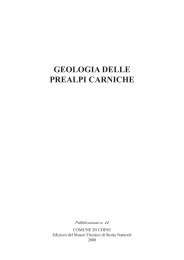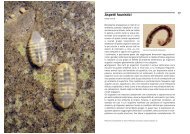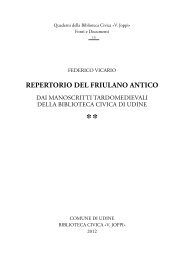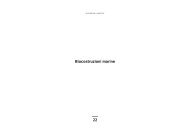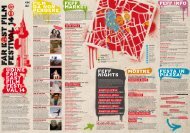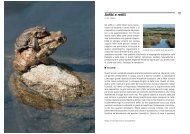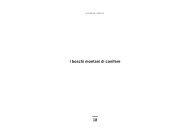Despite its inhospitable appearance and lack of any ... - Udine Cultura
Despite its inhospitable appearance and lack of any ... - Udine Cultura
Despite its inhospitable appearance and lack of any ... - Udine Cultura
You also want an ePaper? Increase the reach of your titles
YUMPU automatically turns print PDFs into web optimized ePapers that Google loves.
52<br />
collected in phreatic waters in Umbria <strong>and</strong> caves <strong>of</strong> Liguria <strong>and</strong> Friuli Venezia<br />
Giulia, Sketodrilus flabellisetosus in the Trieste Karst, <strong>and</strong> Aktedrilus ruffoi,<br />
recently described on specimens found in interstitial environments <strong>of</strong> the river<br />
Tione (Verona).<br />
Enchytraeids are less well-known, <strong>and</strong> several species <strong>of</strong> Cernosvitoviella, found<br />
in Pre-Alpine caves <strong>and</strong> considered to be stygobionts, are still being examined.<br />
■ Ostracods<br />
Ostracods (from the Greek ostrakon, shell) are a diversified group <strong>of</strong> small<br />
crustaceans, whose body is enclosed by a bivalve carapace made <strong>of</strong> calcite,<br />
their unmistakable characteristic. Their carapace may be egg-, bean- or<br />
trapezoid-shaped, <strong>and</strong> is <strong>of</strong>ten knobbly or dimpled. The number <strong>and</strong> shape <strong>of</strong><br />
their appendages is generally the same.<br />
Freshwater species have eight pairs <strong>of</strong> appendages, four <strong>of</strong> which are<br />
cephalic (antennules, antennae, m<strong>and</strong>ibles, <strong>and</strong> maxillulae), three thoracic,<br />
<strong>and</strong> one caudal (uropod). They are generally small-sized (stygobionts<br />
seldom exceed 1 mm in length), <strong>and</strong> are found in all types <strong>of</strong> surface- <strong>and</strong><br />
groundwater.<br />
<strong>Despite</strong> their large numbers in groundwater, both in caves <strong>and</strong> alluvial<br />
aquifers, stygobiont mussel shrimps are little known in Italy, <strong>and</strong> m<strong>any</strong><br />
Cypria cavernae (ca. 100x) Pseudolimnocythere sp. aff. hypogea (ca. 100x)<br />
species are still being studied. Among the most interesting is Cypria<br />
cavernae, thought to be endemic to alkaline karstic waters in Gorizia, Trieste<br />
<strong>and</strong> Slovenia. Other species are associated with anchialine habitats, like<br />
those in underground lakes <strong>of</strong> coastal caves in the Salento in Apulia<br />
(Trapezic<strong>and</strong>ona stammeri, Pseudolimnocythere hypogea). Specimens <strong>of</strong><br />
the genus Pseudolimnocythere were found in the brackish water <strong>of</strong> the<br />
Poiano springs, which issue from Triassic evaporites in the upper Val<br />
Secchia.<br />
A very interesting genus from the palaeogeographical viewpoint is<br />
Sphaeromicola. It is a commensal species living exclusively on stygobiont<br />
isopod crustaceans <strong>of</strong> the genera Monolistra (Sphaeromicola stammeri, in the<br />
Pre-Alps) <strong>and</strong> Sphaeromides (Sphaeromicola sphaeromidicola, in the Isonzo<br />
Karst). The same genus includes a commensal species on marine amphipod<br />
crustaceans, showing how both these ostracods <strong>and</strong> their hosts had marine<br />
ancestors.<br />
Mussel shrimps are very interesting in palaeogeographical research, because<br />
their shells are easily conserved in sediments, where they fossilise. The large<br />
numbers <strong>of</strong> fossil species, together with the great diversity <strong>of</strong> living ones,<br />
provide detailed information about the evolution <strong>of</strong> the animals <strong>of</strong> this class.<br />
Unfortunately, since stygobiont species are little known, have rarely been<br />
used to analyse the origin <strong>and</strong> evolution <strong>of</strong> stygobiont fauna.<br />
53




